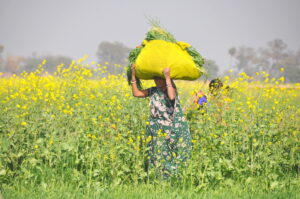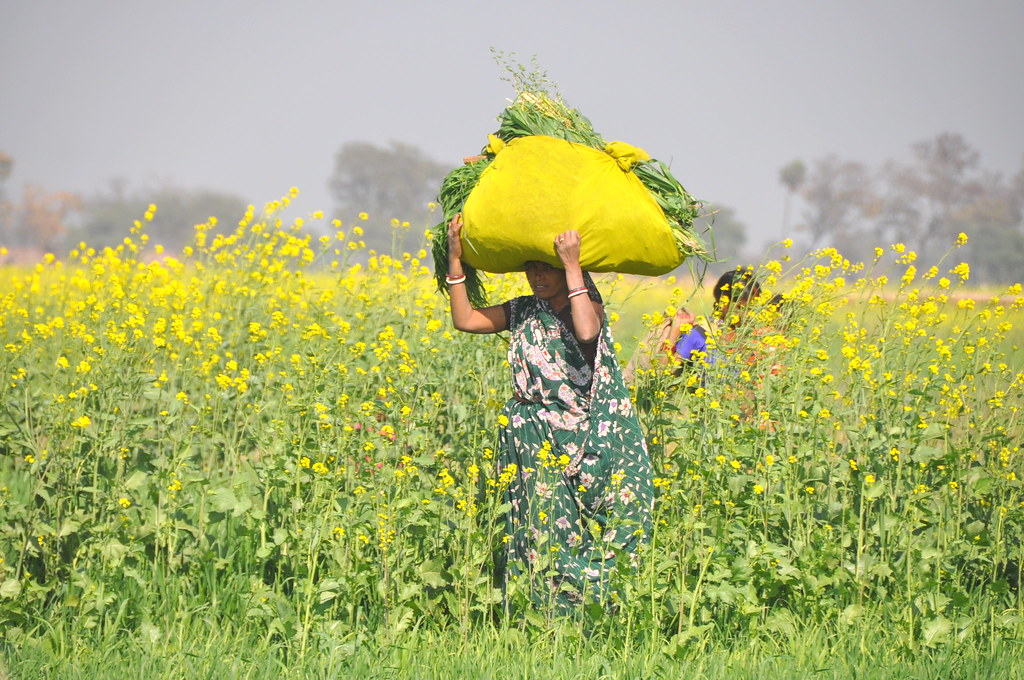Far from seeing doubled incomes, farmers are caught in the pincer of low unfair prices for their produce and ever rising input costs.
 Farmers were enticed by Narendra Modi and the Bharatiya Janata Party in 2014 with an attractive promise that their produce would be procured at a Minimum Support Price (MSP) at least one and a half times the comprehensive cost of production according to the C2+50% formula. The relentless dinning of the promise had generated hope in no small measure and helped sway rural voters in many states in favour of the BJP. The high hopes, however, burst asunder when the Narendra Modi-led Union Government filed an affidavit in the Supreme Court that it would not be possible to determine the MSP according to its promise as such increase would distort the market.
Farmers were enticed by Narendra Modi and the Bharatiya Janata Party in 2014 with an attractive promise that their produce would be procured at a Minimum Support Price (MSP) at least one and a half times the comprehensive cost of production according to the C2+50% formula. The relentless dinning of the promise had generated hope in no small measure and helped sway rural voters in many states in favour of the BJP. The high hopes, however, burst asunder when the Narendra Modi-led Union Government filed an affidavit in the Supreme Court that it would not be possible to determine the MSP according to its promise as such increase would distort the market.
On February 28, 2016, on the eve of the Union Budget, Prime Minister Narendra Modi made yet another promise on ‘doubling farmers’ income’ (DFI) by 2022, as India completes 75 years of independence. A year later, at the peak of protests demanding implementation of the promise of MSP at C2+50%, in May 2017, Amit Shah, the then BJP president, made an audacious claim that within three years of coming to power, the 2014 poll promise was nearly fulfilled and the MSP was 43% more than the cost of production if the cost of land is excluded from the price calculation. He also asserted that MSP by taking into account the land price was impossible to implement.
The Ashok Dalwai Committee on DFI was set up on April 13, 2016. The Committee set the time frame for achieving the target from 2016-17 to 2022-23, with 2015-16 as the base year. Extrapolating from 2012-13 NSSO estimates, the average annual income of the farmer at the national level in 2015-16 was taken as Rs 96,703 i.e., about Rs 8,058 per month for a farm household. The targeted farmers’ income at the national level in 2022-23 according to the Committee was to be Rs 2,71,378 at current prices or Rs 22,610 per month. Achieving this target, the Committee pointed out in its report, required a farm income growth rate of 10.4% per annum. However, the committee did not provide a coherent strategy of providing technological or economic support to farmers that would help raise yields and incomes. The mammoth report running into 14 volumes did not say anything about steps that need to be taken to ensure that farmers received C2+50% price for their produce.
It has now come to light that a separate Special Task Force on DFI was also set up by the Niti Ayog in January 2018, acting on a letter by one Sharad Marathe, an NRI businessman with no known expertise in agriculture who submitted a concept note titled “Doubling of Farmers’ Incomes Through Market Driven, Agri Linked Made in India”. While the final report of this task force, also led by Ashok Dalwai, is not available, it is known that the task force only talked to select private companies in an apparent attempt to identify steps that the government was to take to promote interests of private companies in agriculture and related economic activities.
The 77th round of Situation Assessment Survey of Agricultural Households released in 2021 shows that the estimated monthly income of farm households in 2018-19 was merely Rs 10,218 per month in nominal terms. This will be about Rs 1,22,616 annually, which although midway before the targeted 2022 deadline for DFI, is nowhere close to the targeted income of Rs 2,71,378 at current prices or Rs 22,610 per month.
What then came was a fig leaf in the form of a report by State Bank of India’s Economic Research Department (ERD). Claiming to have used “a well-spread, well-represented and probabilistic sample to estimate the change in income from FY18 to FY22 for all segments of farmers, large to small to marginal ones” based on primary data of SBI agricultural portfolio across states and “granular data of various crops from agri-intensive branches” it loudly announced that farmers’ income doubled in FY22 as compared to FY18 for certain crops in some states (like soyabean and sugarcane in Maharashtra, cotton and paddy in Karnataka, wheat in Rajasthan, and groundnut and cotton in Gujarat), while in all other cases it rose in the range of 1.3-1.7 times.
While ERD did not come up with an explanation of the methodology, sample size, cost calculation, the distribution of respondents across different classes of the peasantry, the basis on which farmers’ incomes were calculated or why Rajasthan, Gujarat, Maharashtra and Karnataka were chosen, these shoddy claims unfortunately got wide coverage in the media. The ERD study also kept out the landless tenants who do not come under the purview of crop loans. Even if for a moment we ignore the lack of clarity on the methodology used and the fact that the receivers of bank loans do not represent the entire spectrum of peasantry, extrapolating these results to claim that farmers’ incomes doubled in 2022 is little more than a far-fetched attempt to please those at the helm.
Any observer of agricultural costs and prices knows that MSP is mostly notional as there is no assured procurement in most cases. The procurement as a percentage of total production in 2021-22 was 0% for soyabean and as low as 2.05% for groundnut. Farmers are forced to make distress sales at prices lower than the MSP while traders make a killing at their expense and fleece the consumers. The level of procurement of paddy and cotton in Karnataka, and wheat in Rajasthan is very negligible and cannot buttress the claim that the MSP announced boosted farmers’ incomes and better price discovery. There is no public procurement of sugarcane and the farmers face a unique situation of delivering their harvest but not receiving payment from corporate sugar mills, leading to mounting arrears in thousands of crores.
Let us now look at the ground reality.
The MSP for the Kharif season 2023-24 announced on June 7, 2023 claiming to “ensure remunerative prices” and “encourage crop diversification” is neither fair nor remunerative. It belied the hopes of the farmers and inflicts huge losses in their incomes. Let alone encouraging crop diversification, it discourages farmers from investing in agriculture. Rather than Doubling Farmers’ Incomes, rising input costs coupled with unfair MSP are pushing large sections of the farmers especially, the small, marginal, middle farmers as well as tenants into indebtedness. Instead of C2+50%, the regime has conveniently shifted goalposts to using A2+FL as the benchmark cost which do not include rental value of owned land and interest on owned fixed capital. There is a catch even in the prices calculated as per the A2+FL formula. The official cost of cultivation surveys significantly understates cost of cultivation across each state, which is then averaged by the Commission of Agricultural Costs and Prices (CACP) to compute the MSP. The CACP document Price Policy for Kharif Crops, The Marketing Season 2023-24 admits that the estimates of projected cost of production for paddy by the governments of Andhra Pradesh, Bihar, Karnataka, Kerala, Maharashtra, Punjab, Tamil Nadu, Telangana and West Bengal are higher than the CACP projections. For paddy, the C2 cost projected by the Kerala State Agricultural Department is Rs 2,847 per quintal, the CACP projection is only Rs 2,338 per quintal. The Punjab state projection of C2 cost for paddy is Rs 2,089 per quintal while the CACP projects it as only Rs 1,462 per quintal. In most crops the state projections are much higher than the CACP projection.
The CACP estimates of costs fail to adequately take into account increasing input costs or factor in the inflation. The Double Engine Sarkar even did not bother to take the recommendations of states ruled by the BJP into consideration. In view of the higher cost of production in Kerala, the LDF government gives about Rs 800 per quintal bonus for paddy, procuring at Rs 2,850 per quintal. Such initiatives, discouraged by the BJP government on the ground that these are market-distorting, are a lifeline for agriculture and farmers.
Even if one takes the CACP computation of C2 costs (Rs 1,911 per quintal) and applies the C2+50% formula to calculate the MSP of paddy, it should have been Rs 2,866 per quintal. The MSP announced as per (A2+FL)+50% is only Rs 2,183 per quintal or about Rs 700 per quintal lesser. If the weighted average of C2 costs provided by the states (Rs 2,139 per quintal) is taken into account, the MSP would have been Rs 3,208.5 per quintal. In both cases the MSP is way below and farmers will accrue a loss of Rs 683.5 per quintal and Rs 1,025.5 per quintal respectively. A farmer in Andhra Pradesh with a productivity of six tonnes per hectare will incur a loss of Rs 41,010 per hectare and Rs 61,530 per hectare respectively at these costs. This will translate into a loss of anything between Rs 9,020 crore to about Rs 13,540 crore per season for farmers of the state (paddy is cultivated in more than 22 lakh hectares in AP).
In the case of cotton, the Telangana state C2 projections are Rs 11,031 per quintal while the CACP projections are only Rs 6,264 per quintal. Even if we take the CACP projection of C2 for cotton (Rs 5,786 per quintal), the C2+50 price should be Rs 8,679 per quintal while the government announced an MSP of only Rs 6,620 per quintal. Taking an average production of 15 quintal per hectare, the losses will be Rs 30,885 per hectare. As per the state, C2+50 would be Rs 16,547 per quintal or Rs 9,927 per quintal more than the MSP announced. That would mean a loss of Rs 1,48,905 per hectare. Given that the state has an acreage of about 19 lakh hectares, the losses at Central MSP and state-proposed MSP will be ranging from about Rs 5,868 crore to Rs 28,291 crore. One can imagine the huge disincentive to a farmer and the reason why farm suicides are rising in the cotton belt.
If we take the case of rubber, in 2011 a farmer was getting Rs 230 per kg and recently it had fallen to Rs 124 per kg. If a farmer with one hectare produces on an average 1,500 kg, the income was Rs 3,45,000 which in 2023 fell to Rs 1,86,000 or a loss of Rs 1,59,000. One can imagine the losses and the meagre returns if the increasing costs of cultivation are taken into account. Faulty trade policy, the India ASEAN Free Trade Agreement, import at zero duties and so on at the behest of corporate cronies and tyre manufacturers further pushed farmers into crisis. The losses suffered by farmers are in thousands of crores even as the tyre manufacturers are filling their coffers.
Farmers are caught in the pincer of low unfair prices for their produce and ever rising input costs as deregulation has given a free hand to the companies to fix prices without any control. Often the ruse used is that increase in MSP will increase prices for consumers, but nothing is done to stop profiteering at the expense of farmers and consumers. Even the Dalwai Committee recognised that there is a need to increase productivity with better agronomic practices, high yielding varieties and keep the costs of production lower by providing subsidised quality inputs at affordable rates. However, the entire thrust seems to be at the behest of corporate companies, international monopolies and agencies as well as individuals advocating interests of predatory agribusinesses. The current government has refused to take the responsibility, devise a strategy of public provisioning of these critical forms or support, and provide resources for meeting this responsibility. The policies do not even take into account that fact that supporting farmers and agriculture is of strategic interest for food security of the country.
Inflicting losses on farmers to deliberately push them into indebtedness, pauperise and dispossess them from their land is the direction in which the BJP government is moving. It also serves their purpose of maximising profits of the corporate companies. The three Farm Acts and the amendments to the Electricity Act are all part of the game plan to squeeze farmers out of cultivation. Increasing input costs and low yields and low prices are making agriculture unviable for farmers. It has been raining promises and assurances but farm distress is deepening, as shown by nearly four lakh suicides by farmers, agricultural workers and migrant daily wage labourers in last decade. The BJP government has only succeeded in doubling farmers’ woes. ‘Modi Ki Guarantee’ is for corporate cronies who have been profiteering amidst farm distress and not just doubled their wealth but seen manifold increase. It has only sown death and destruction in farmers’ lives.
This article is the first in a series on the state of Indian economy co-curated by the Centre for Financial Accountability, New Delhi and The Wire.
This article was originally published in The Wire and can be read here.
Centre for Financial Accountability is now on Telegram. Click here to join our Telegram channel and stay tuned to the latest updates and insights on the economy and finance.
Vijoo Krishnan is a writer and General Secretary of All India Kisan Sabha.


